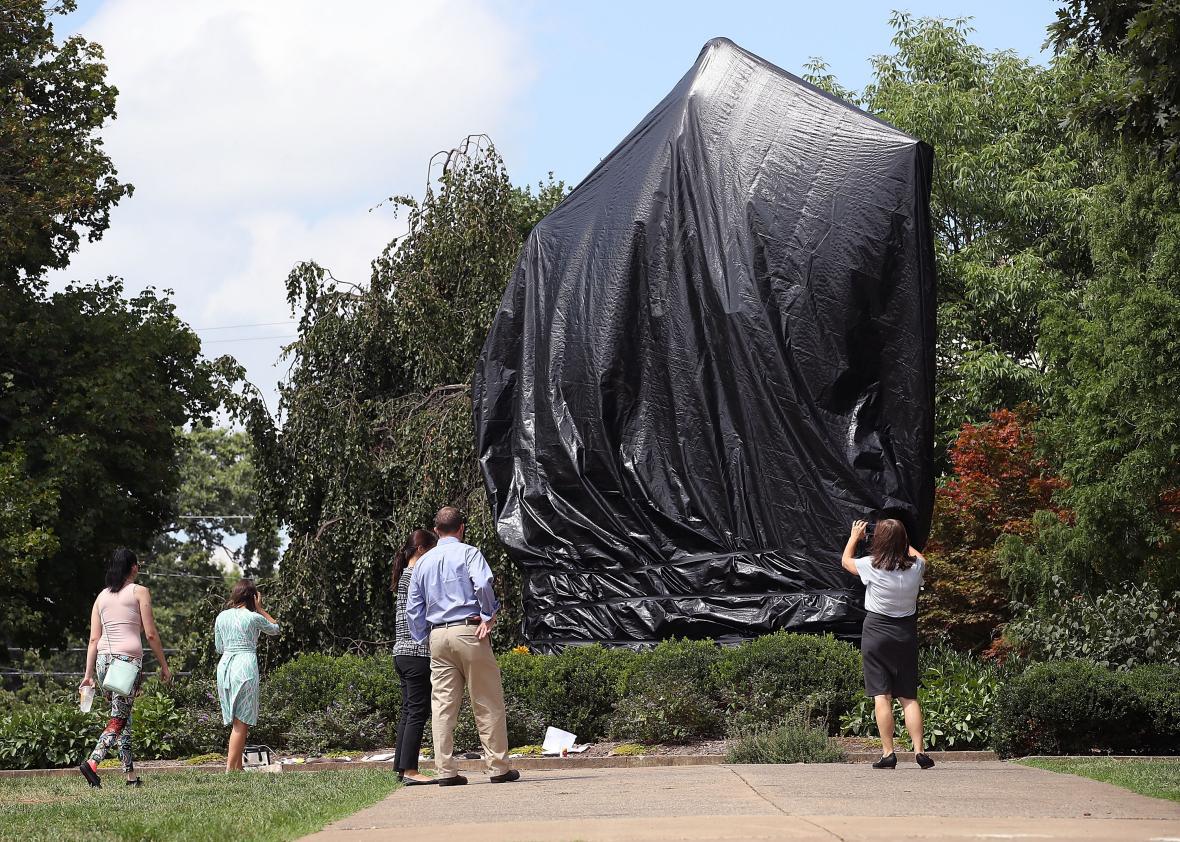Want to listen to this article out loud? Hear it on Slate Voice.
On Wednesday, the city of Charlottesville, Virginia, shrouded two of its Confederate monuments in black. City officials would like to remove the statues of Robert E. Lee and Thomas “Stonewall” Jackson altogether, but they are currently under a court order blocking the removal of one statue, and they are likely to face similar legal obstacles to removing the other. A Virginia law appears to deprive Charlottesville of legal authority to alter its Confederate monuments. Many other cities face similar state laws prohibiting the removal of monuments.
So far, the lawsuit over Charlottesville’s monuments has focused on arcane issues of state law. But there are larger constitutional principles at stake—most importantly, that the government is prohibited from conveying messages that denigrate or demean racial or religious minorities. While private citizens may engage in hate speech under existing law, the government may not demean racial or religious minorities without running afoul of the guarantee of equal protection contained in the 14th Amendment. Unlike limitations on hate speech, which remain controversial, this rule against racialized government speech should enjoy widespread support.
An implication is that the city of Charlottesville has constitutional grounds for challenging any Virginia law that prevents it from removing a statue that communicates a message of white supremacy. City council members have a sworn obligation to uphold the Constitution, and if they believe that the monuments violate equal protection as guaranteed by the Constitution, they have an obligation to take them down.
To see the force of this rule, consider an analogy with government speech concerning religion. Private citizens may declare their support for religion; indeed, they are constitutionally protected when they do so. But it would be unconstitutional for a government to do the same. A government cannot erect a sign declaring “This town is for Christians” or even just “Jesus saves.” Either sign would violate the principle of separation of church and state enshrined in the Establishment Clause of the First Amendment. It would create stratified classes of citizens on the basis of religion. And government endorsement of religion would be unconstitutional even if the government were “merely” speaking, with no other tangible or legal consequences.
Similarly, a local government could not erect a sign that read “This town is for whites.” Racialized messages by the government are prohibited, just as religious messages are. The legal source of the prohibition is different—it comes from the Equal Protection Clause, rather than the Establishment Clause. But the idea is analogous, namely that no one may be relegated to a demeaned status by public officials.
Does the constitutional rule against racialized speech by the government apply in Charlottesville, so that the city is required to remove the memorials? Yes, because the statues of Lee and Jackson communicate a message of racial inferiority. While sometimes it can be difficult to discern the meaning of government symbols, it is not as difficult in this situation. History and context would lead a reasonable and informed observer to conclude that the memorials endorse slavery and subordinate black Americans.
Charlottesville’s statue of Lee was erected not immediately after the Civil War but in 1924, during the height of Jim Crow. According to at least one account, it communicated a message of exclusion to residents of Vinegar Hill, a black neighborhood. And the Jackson monument was unveiled in 1921 during the annual reunion of the Confederate Veterans and the Daughters of the Confederacy. It is situated in what was once McKee Row, a majority black neighborhood that was taken from its owners and granted to the city. Both monuments were part of the Lost Cause narrative, which sought to depict the Civil War as a battle for states’ rights, rather than a fight over slavery. The white supremacists who marched on Charlottesville after the city proposed to remove the statues surely understood those messages.
In Charlottesville, the constitutional argument matters in a concrete way. City officials actually want to remove the statues of Lee and Jackson. They have been stopped by a state court, relying on the Virginia law. But the United States Constitution is superior to any state or local law. Charlottesville officials should rely on its authority to conclude that they not only may but must remove these Confederate monuments. While legal technicalities may make it tricky to challenge the constitutionality of the monuments in court, those complexities do not apply to city officials. If they prefer, they could relocate the statues to a museum, where they could be placed in historical context. That would remove any constitutional difficulty. And it would signal to city residents, and to Americans everywhere, that the Constitution stands for full and equal citizenship for everyone.
